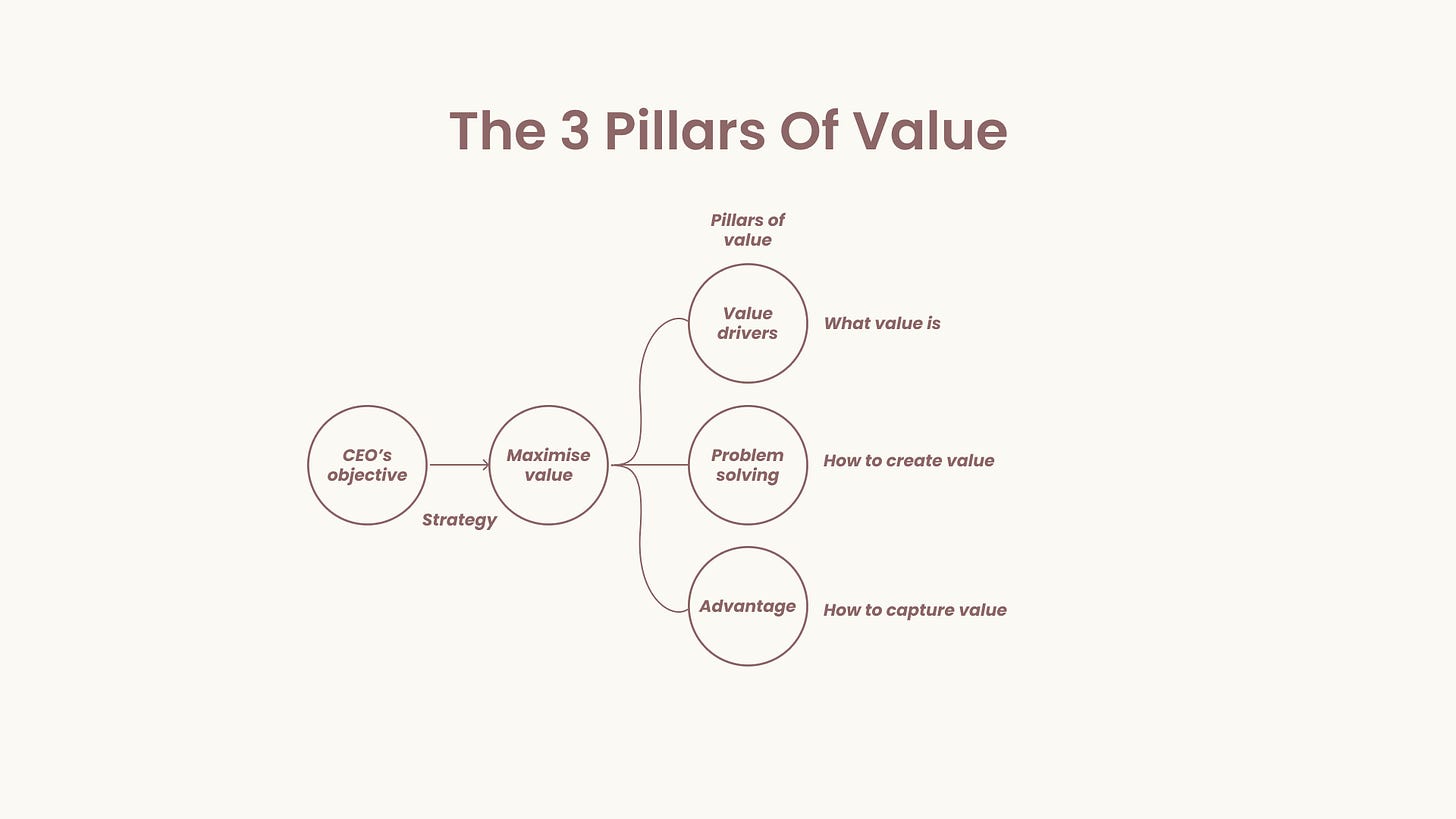The point of strategy is to figure out how to allocate resources under uncertainty.
And the objective? To maximize value.
Strategy and value are joined at the hip. Value starts with the customer. Customers trade money for solutions to their problems. This generates revenue, which flows to employees as salaries, governments in the form of taxes, and shareholders as profits. In turn, competitive pressures determine how value is distributed among the parties.
To be good at strategy, you need to understand 3 pillars
What value is (the value drivers)
How to create value (by solving problems)
How to capture value (through competitive advantages)
These can be considered non-negotiables for the ambitious strategist.
Value Pillar #1: The Value Drivers
The value of a business is driven by the cash flows it can generate over its lifetime.
Cash flows are driven by three things
How many customers you have
How much you make per customer
Fixed costs
Obviously, that’s only the starting point. These three drivers go several levels deep. For example, the number of customers is a function of a) existing customers and b) new customers. In turn, new customers are a function of c) how many customers who buy each period (in the market) and e) how many of those we get. In turn how many of those we get is driven by f) our win rate and g) our distribution reach. And our win-rate is a function of h) our value proposition versus i) competitors’ value propositions across segments
The cornerstone of high-level strategy is a logic tree that breaks down the drivers of value (commonly known to as a Value Driver Tree)
Value Pillar #2: Problem Solving
To create value, we must solve problems, either for customers or for the company.
When we solve a problem a new way, we call it innovation. And when we solve problems fast, we call it operational excellence. Any new business that succeeds first innovates and then executes really well. And both reflect problem-solving ability.
There are 3 keys to problem-solving
The 5 step problem solving process
The 4 drivers of problem solving output
Non-linearities
Problem Solving Key #1: The 5 Step Problem Solving Process
Problem solving is an iterative process.
Understand the problem
Think of solutions to each part of the problem
Build solutions
Test the solution in the real world
Learn what worked and iterate
These 5 steps are universal to any problem. But since problems vary a lot, some require more or less effort in each step. If you’re figuring out a marketing headline, you need to understand less and test more to find the best solution. If you’re building a rocket you want to understand more and test less, because blowing up a rocket is expensive. But it’s the same process.
When the rocket blows up, you figure out why and try again.
Problem Solving Key #2: The 4 Key Drivers Of Problem Solving Output
What drives extraordinary problem solving performance?
It’s a question that’s easier to answer through inversion. Inversion is a technique popularized by Charlie Munger. The idea is that abstract problems are easier to solve in reverse. So instead of asking: “how do we achieve world class problem solving?”, it’s much simpler to find the answer by asking “what would make us solve problems incredibly slow?” - and then inverting.
Four things slow down problem solving
Lack of skill (don’t know how)
Lack of capacity (don’t have time)
Lack of motivation (don’t want to)
Dependencies (Need to wait for others’ input)
Surely, it will take me a lot of time to build rockets. For one, I have no idea of how to build a rocket. Learning this would take ages. Moreover, I have no time for it. Which means that even if I knew how, it would still take ages. And I don’t really want to. So even if I did have skills and time, it wouldn’t happen. Last, if I had all three (skills, capacity and motivation), but depended on my boss’s boss approval for any design change or budgetary question, I would still move at snail’s pace.
So, if we invert back, fast problem solving requires:
Skill (I know how)
Capacity (I have the time)
Motivation (I want to)
Autonomy (I can do it without waiting for others)
Problem solving speed and quality comes down to these four drivers. It’s a mix of the quality of people, how one directs their capacity, how one incentivizes them, and how one is organized.
Managing this as a company scales is one of the fundamental challenges of business.
Problem solving key #3: Non-Linearities / Leverage
Non-linearities (or leverage) are relationships that yield exponential gains.
In the most general sense, it’s about bang for the buck. We put more in and get even more out. Yet, because they are a) counterintuitive and b) hard to measure, we need to know about them to use them.
Here are three examples of “non-linear” relationships:
The impact of excellent quality
The power of experimentation
Finding the needle in the haystack
Non-Linearities Example #1: The Impact Of Excellent Quality
Excellent quality massively outperforms average quality.
For example:
Writing a 9.5 / 10 book may require 20x the effort, but produce 1000x the sales
The best knowledge workers produce 10-50x the output but cost only 1.5-5x more
Customers with a 9/10 satisfaction score generate word-of-mouth, while customers with a 7/10 don’t
Moreover, these gains drive momentum and are often self-reinforcing.
For example, A-players hire A-players, while B-players hire C-players.
Non-Linearities Example #2: The Power Of Experimentation
We lose most of the time, but sometimes win big.
Examples:
1 successful innovation might pay for thousands of failed experiments
Testing different marketing headlines might uncover one that 10x your sales
Testing different pricing levels helps identify the optimal price point
Experimentation is a game of delayed gratification. Most efforts fail, which is a challenge both psychologically and politically. People don’t like a string of failures. Even the most stoic person would question himself after failed attempt #40.
Still, experimentation is a worthwhile pursuit.
Non-Linearities Example #3: Finding The Needle In The Haystack
These are single flashes of insight that unlocks a new level of performance.
For example:
Diving deep into customer problems might reveal one insight that opens a new market
Understanding a single nuance about customer preferences might unlock market share
Reading about one concept might be the unlock to a major problem you are facing
The mountain bike was invented after a bike repair shop noticed large volumes of snapped frames from customers. In the early days of the toothpaste market, Pepsodent’s competitors struggled to gain share - until a focus group revealed it was the tingly sensation of the mint that kept customers loyal. When Tesla tried to meet impossible production targets, it figured it could use a tilted assembly line inspired by World War II aircraft manufacturing to speed up production.
In these examples, a single point of insight delivered enourmous value.
Value Pillar #3: Competition and competitive dynamics
Competitive advantages are patterns that make it uneconomical for others to eat into your profits.
For example, I knew a company that built a revolutionary mobile payments solution. It checked all the boxes. Exceptional founder. Legendary VC. Great product. Flawless execution. And an early market lead.
It was sailing towards unicorn status.
Then the leading retail bank woke up.
It hired 100 engineers from India, built a competing solution and pushed it in all its channels. It quickly took over the market, and when the network effects started spinning, the bank became unbeatable. The retail bank had a technology disadvantage, but a nearly invincible resource and distribution advantage.
It’s usually not enough to simply solve a big problem and do everything right. We need an advantage to build a great company.
Therefore, understanding the sources and patterns of competitive advantage is fundamental in strategy work.
Strategy Mastery Means Value Mastery
The point of strategy is to find the path to maximized value.
Value has three pillars. The first is understanding. You need to understand value drivers and their relative importance. The second is value creation, which boils down to problem solving and the drivers of problem solving output. The last pillar is advantage - the structural asymmetry that protects the value you create from erosion by competitive pressures.
For strategists to do their job well, they need to master all three pillars of value.
EDIT: I’ve made some improvements and clarifications the piece based on thoughtful comments. Much appreciated.























